Dialing in the Standard Height for Fireplace Mantels
Author: Rick Worst | Editor: Omar Alonso
Review & Research: Jen Worst & Chris Miller
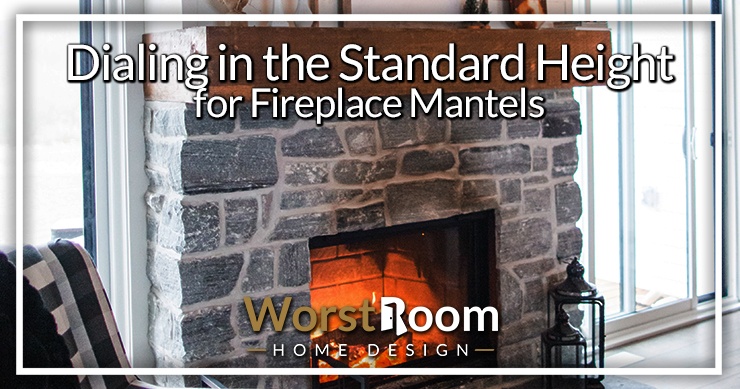
Are you installing a fireplace in your home? Fitting a mantle above the fireplace is common in most homes. You'll need to know the optimal height for installing the mantle and the specific factors you need to consider for correct placement. Firstly that the standard height for fireplace mantels is approximately 54 inches from the hearth floor.
What people fail to understand is that this 54 inch measurement is a general guideline and not set in stone. There are several factors accounting for optimal mantel height above the fireplace and the building code allows for some variance.
This post unpacks the difference between optimal and standard mantel heights and how to position the mantel for things like mounting your TV. Let's unpack everything you need to know about the topic.
Optimal Height vs. Standard Height for Fireplace Mantels
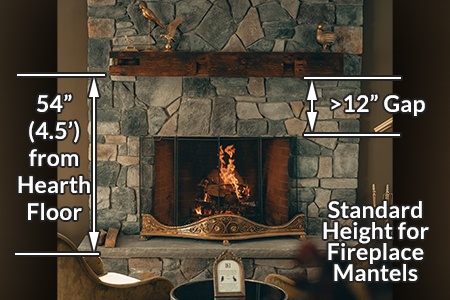
You have the standard and optimal mantel installation heights to consider when installing your new fireplace. Let's look at the differences between the two and give you information to help you decide on the right mantle height for your fireplace.
Standard Height for Fireplace Mantels
The average mantel height refers to an average – so it's not something you need to see as a must-follow guideline. It's not an exact standard height for a fireplace mantel, but there are distances that need to be met or exceeded as well as clearances.
It's merely a suggestion based on what other people use for theirs. There's a huge range across households in fireplace mantle heights, and pinpointing the right height down to the inch is next to impossible for this measurement.
The average height for most fireplace mantels is 54 inches, around 4.5 feet from the hearth floor. This measurement represents a good starting point when considering your installation height.
You'll have variations on this measurement depending on the ceiling height, the size of your living room, mantel construction materials, and the size of your fireplace.
Optimal Height for Fireplace Mantels
The fireplace mantel has dual safety purposes. It's not only ornamental in its design but functional as well. The mantel absorbs and disperses heat from the fireplace, protecting the ceiling and the immediate area above the fireplace opening. The mantel also blocks sparks from jumping out of the fireplace.
We'll discuss the National Fire Protection Association (NFPA) safety and installation standards to help you place your fireplace mantel at the optimal height from the floor. Remember, there's a typical mantel height, but not a standard, exact height. It's based on the distance from the fireplace, which can vary in height.
Depending on your fireplace depth, the standards state that your mantel should be at least 12 inches from the top of the firebox opening. The deeper your fireplace, the higher you must place the mantel. You can't ignore this even with fireplace alternatives like electric options, because it's not about flames, it's about heat.
Understanding Fireplace Mantel Design & NFPA Standard Dimensions
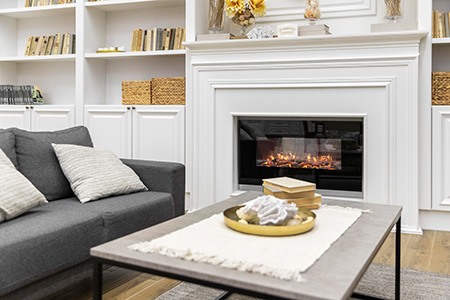
The NFPA code standards (you can view for free there, but may have to register a free account first) has three standard dimensions for the size of your fireplace mantel in terms of depth, width, and thickness.
Mantel Thickness
The thickness depends primarily on the mantel's construction materials. The optimal depth for the mantle is between three to seven inches.
Mantels featuring thinner construction materials, such as planks, can be three to four inches thick, and planks can be about three to four inches thick. And mantels featuring materials like logs will require thicknesses of between five to seven inches.
Heat dispersion is the biggest consideration when planning mantel thickness. Thinner materials disperse heat faster than thicker materials. That's why you make thinner mantels out of lightweight materials. Thick logs or stones disperse heat slowly, causing temperature build-up above the mantel.
The heat absorption will depend on if you're at or above the standard height for fireplace mantels, too. Too close and you risk a fire, and further away means less heat to absorb and thus thinner materials you can use.
Mantel Depth
The optimal fireplace mantel depth describes the proper distance the mantel extends from the wall. According to NFPA best practices, the mantel must extend past the fireplace for a minimum of three inches.
If your fireplace sticks out from the wall, consider this measurement, and add three inches to it to get the optimal mantel depth. If you're planning on setting decorations or ornaments on the mantel, make it wider and deeper than these dimensions.
Mantel Width
There are no NFPA regulations on optimal mantel width. Typically, your mantel should be six inches wider than the width of the fireplace on each side. You can also look for balanced proportions to your mantel width and depth if you're going for a particular visual aesthetic.
Understanding the Optimal Mantel Height for the Room & Fireplace
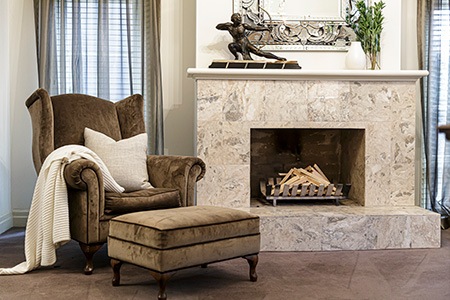
The size of the living room also plays a role in considering the optimal mantel installation height as well as the types of fireplaces we're talking about. The average ceiling height in new houses is 8 feet.
If that's the case for your home, the fireplace should be approximately 48 inches from the hearth floor, and you'll add at least 12 inches above the firebox, giving you a minimum mantel height of 60 inches.
Remember, this measurement is from the hearth floor of the fireplace. The hearth floor is where you place the logs inside the firebox. Most fireplaces have raised the hearth floor to allow for airflow under the logs and accumulation of ash away from the combustion materials for better burning.
The fireplace and mantel are strong focal points in the living room, so they need a proportional look to prevent them from dominating the visual aesthetic of the space. Keep your fireplace and mantel design from overpowering the wall. Ensure it's in balance.
How to Measure Mantel Height
Start by measuring 54 inches from the hearth floor to the mantel base. If you have a 42-inch high firebox, your mantel base must be at least 12 inches above this point. Exclude flue curvature from this measurement (the flue being the chamber that flows heat and smoke out through your chimney types).
Fireplaces come in several sizes, designs, and depths, so it's common for people to work with non-standard dimensions. For this reason, the points discussed thus far are mostly guidelines, and nothing is set in stone.
What Measurement is Too High for the Mantel?
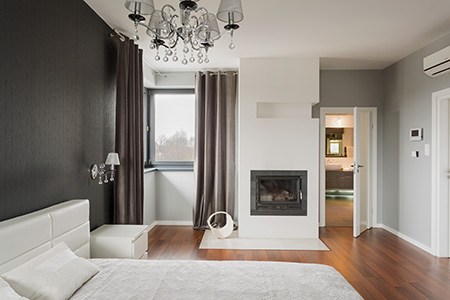
Your primary goal with mounting your fireplace mantel is to create a balanced aesthetic for the mantel and fireplace, blending into the room. With the right proportions, most mantles have a base around 12 inches from the top of the firebox.
As discussed, you'll have to increase this distance for deeper fireboxes. A good rule of thumb suggested by the NFPA is to add an inch of height for every inch of fireplace depth over two inches in your fireplace firebox. Ensuring you keep the fireplace wall balanced means having enough space from the ceiling to the mantel.
In rooms with 8-foot ceilings, you'll want from two to 3.5 feet of space above the mantle. You can fill this space with decorations or appliances like your TV. As you can imagine, the standard height for fireplace mantels doesn't change, so you'll have less height above the mantel with shorter ceilings.
In rooms with lower ceilings, you'll have to consider if it's worth it to have a TV above the fireplace mantel, but we'll discuss this topic in detail later. Stick around for the FAQs, and we'll settle this for you.
Tips for Using the Space Above Your Mantel
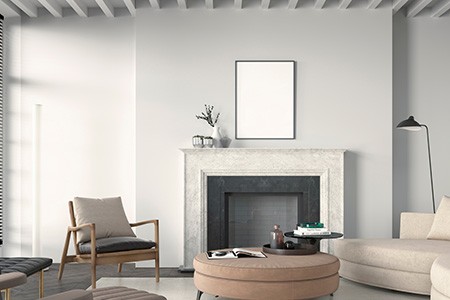
How do you plan on using the space above the fireplace mantel? Typically, homeowners use it to mount a TV. For optimal mounting and use of the TV without damaging it, you'll need a room with a minimum floor-to-ceiling distance of 9 feet.
Since the average ceiling height in homes is 8 feet, you must consider if it's worth adopting this approach if that's the case for your home.
If you have a 9-foot ceiling, you shouldn't have any problems mounting the TV above the fireplace. This strategy creates an interesting visual dynamic for the room, where the TV and fireplace become the central focal points, creating a compatible design dynamic.
FAQs Regarding Mounting TVs Above a Fireplace Mantel
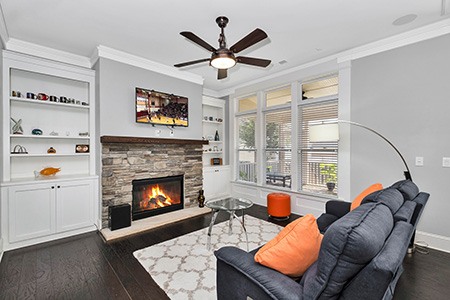
Any time you talk about a mantel these days, everyone wants to shift the conversation towards whether or not a TV should be mounted above it. Some love it, some are stuck with it based on the room design, and some absolutely hate it. Let’s break that down.
Should I Mount a TV Above the Fireplace Mantel?
We don't recommend homeowners mount their TV above the fireplace. The heat from the fire could damage the TV if you position it too close. You'll need a minimum ceiling height of 9 feet to consider mounting the TV above the mantel. Anything less is asking for trouble.
You'll need to include the TV installation in your construction plans if you want to take this route. The mantel is important for fire safety purposes, which is why you include it in your planning. The mantel protects the wall and TV above the fireplace from sustaining heat damage. We're obviously only talking about flatscreen types of TVs here.
How High Should I Mount My TV Above the Fireplace Mantel?
Heat is the primary concern when choosing the right mounting height for the TV above the mantel. You'll need to mount the mantel at least 12 inches above the top edge of the firebox. Mount the TV 6 inches above that measurement. The best practices are to mount your TV angling downward, as you might do when mounting a TV in your bedroom.
Does the Mantel Need to Be Wider Than the TV?
Yes, the mantel must be wider than the TV to protect it from heat damage. Depending on the size of your fireplace, we recommend you go with a larger TV. The most popular screen size for wall-mounted TVs above a mantle is between 55 to 57 inches.
Understanding the Standard Height for Fireplace Mantels – Key Takeaways
Below is the re-cap of all we’ve covered so far regarding the correct fireplace mantel height. You’ll find that you’ll struggle between going with the standard height versus going for the optimal height, and that’s okay. There’s ways to get through it:
- When planning your fireplace mantel installation, you'll need to consider the standard vs. optimal installation heights.
- The fireplace should be approximately 48 inches in height from the hearth floor, and the mantle needs to be at least 12 inches above that.
- The mantle's height, depth, and width depending on the materials used in the mantle design.
- Refer to NFPA standards and recommendations on correct measurements for installing your mantel.
- The mantel should have at least 3.5 feet of space to the ceiling above in rooms with 8-foot ceilings.
- You'll also need to adjust your measurements for installation width and height depending on how far the firebox protrudes from the wall, the floor hearth, and the firebox depth.
There is no must-have standard height for fireplace mantels so much as code-based clearances that have to be maintained. We can all achieve that and as long as you do that, you can then make decisions based on aesthetics for a safe yet beautiful fireplace mantel.



